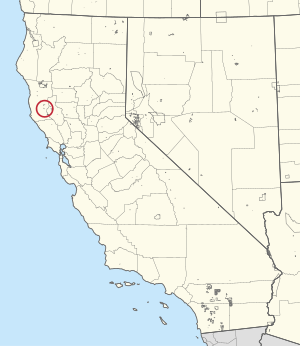Guidiville Rancheria of California facts for kids
Quick facts for kids
Guidiville Rancheria
|
|
|---|---|

Location of the Guidiville Rancheria
|
|
| Tribe | Pomo |
| Country | United States |
| State | California |
| County | Mendocino |
The Guidiville Rancheria of California is a Pomo Native American tribe. They live in Mendocino County, California, in the United States. This tribe is officially recognized by the U.S. government. They have a rich history and continue to grow and thrive today.
Contents
A Look at the Guidiville Pomo Tribe's History
Leaving Ancestral Lands During the Gold Rush
During the California Gold Rush, many non-Native American settlers moved into California. This caused the Guidiville Pomo people to leave their traditional lands. Their ancestral home was near Lake County, California. They were forced to move into Mendocino County.
Unfulfilled Promises: The Treaties of 1851
In 1851, the U.S. government sent officials to talk with the tribe. They wanted to make agreements, called treaties. The Guidiville Band and other Pomo groups agreed to give up their ancestral lands. In return, they were promised new lands.
However, the U.S. Congress never approved these treaties. This meant the Guidiville people never received the lands they were promised. These important documents were hidden away in Washington D.C. They were not found again until many years later, in the 20th century. For a long time, the Guidiville Band had no land of their own.
Life on the Rancherias
Between 1909 and 1915, the government bought small pieces of land. These lands were for Native Americans in California who had no homes. These small areas were called rancherias.
The Guidiville Rancheria did not have enough water or basic services. Life was very hard for the tribe members. Many became sick, and some died young. Some tribal members moved to the Bay Area to find work. Others worked as migrant farm workers, picking hops or fruit.
Reclaiming Their Rights: The Termination Policy
In 1958, the U.S. government ended its official relationship with the Guidiville Rancheria. This was part of a plan called the Indian termination policy. The tribe's lands, which were held in trust for them, were sold to private owners.
In 1987, the tribe took the U.S. government to court. They argued that ending their status was wrong. They won their case! In 1991, the Guidiville tribe, along with the Scotts Valley tribe, settled their lawsuit. This victory allowed the Guidiville tribe to officially reorganize and rebuild.
The Guidiville Tribe Today
Official Recognition and New Lands
In 1992, the Guidiville Rancheria received federal recognition. This means the U.S. government officially recognizes them as a sovereign tribe.
The tribe has bought a piece of land that is about 44-acre (180,000 m2) in size. This land is located about two miles (3 km) east of Ukiah, California.
Tribal Government and Leadership
Today, the tribe's main office is in Talmage, California. The tribe is led by an elected council. This council is headed by a chairperson. Currently, Merlene Sanchez serves as the Tribal Chairperson.

